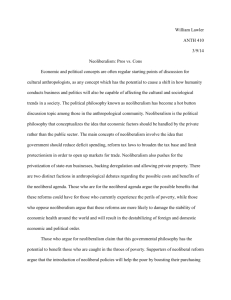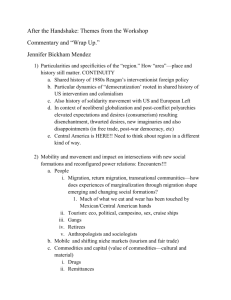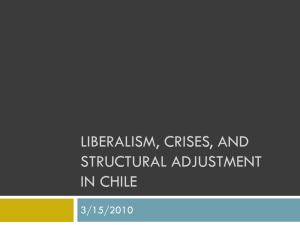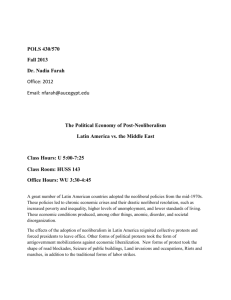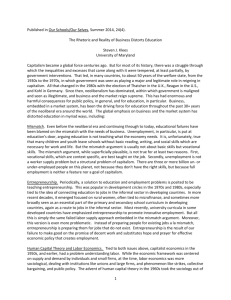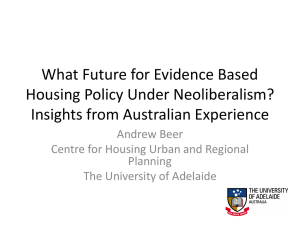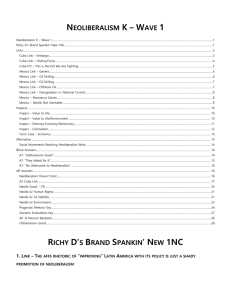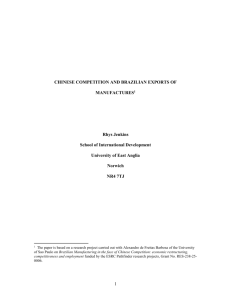Economies of Latin America Part I
advertisement
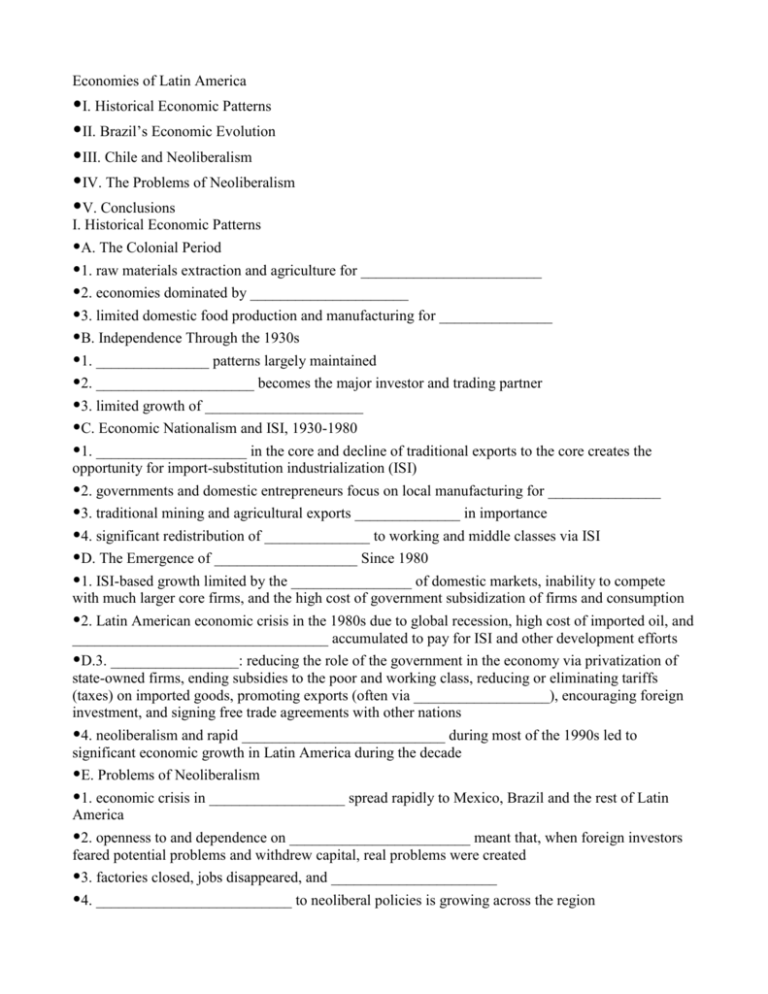
Economies of Latin America •I. Historical Economic Patterns •II. Brazil’s Economic Evolution •III. Chile and Neoliberalism •IV. The Problems of Neoliberalism •V. Conclusions I. Historical Economic Patterns •A. The Colonial Period •1. raw materials extraction and agriculture for ________________________ •2. economies dominated by _____________________ •3. limited domestic food production and manufacturing for _______________ •B. Independence Through the 1930s •1. _______________ patterns largely maintained •2. _____________________ becomes the major investor and trading partner •3. limited growth of _____________________ •C. Economic Nationalism and ISI, 1930-1980 •1. ____________________ in the core and decline of traditional exports to the core creates the opportunity for import-substitution industrialization (ISI) •2. governments and domestic entrepreneurs focus on local manufacturing for _______________ •3. traditional mining and agricultural exports ______________ in importance •4. significant redistribution of ______________ to working and middle classes via ISI •D. The Emergence of ___________________ Since 1980 •1. ISI-based growth limited by the ________________ of domestic markets, inability to compete with much larger core firms, and the high cost of government subsidization of firms and consumption •2. Latin American economic crisis in the 1980s due to global recession, high cost of imported oil, and __________________________________ accumulated to pay for ISI and other development efforts •D.3. _________________: reducing the role of the government in the economy via privatization of state-owned firms, ending subsidies to the poor and working class, reducing or eliminating tariffs (taxes) on imported goods, promoting exports (often via __________________), encouraging foreign investment, and signing free trade agreements with other nations •4. neoliberalism and rapid ___________________________ during most of the 1990s led to significant economic growth in Latin America during the decade •E. Problems of Neoliberalism •1. economic crisis in __________________ spread rapidly to Mexico, Brazil and the rest of Latin America •2. openness to and dependence on ________________________ meant that, when foreign investors feared potential problems and withdrew capital, real problems were created •3. factories closed, jobs disappeared, and ______________________ •4. __________________________ to neoliberal policies is growing across the region II. Brazil’s Economic Evolution •A. The Colonial Era •1. ________________________ controlled production and exports of sugar, gold, oil for lighting from Amazon •B. Independence-1930s •1. continued reliance on _____________________ •2. Rubber Boom in the Amazon made the region one of the _____________________ in the world until the British stole rubber seeds and developed plantations in Malaysia •B.3. Coffee Boom in southern Brazil brought large scale European immigration to supply labor •4. first small scale industries develop to supply the Brazilian market (textiles, household goods) •5. British investment a key part of growth •C. ________________________ and ISI, 1930-80 •1. weakened ties to core reduced markets for exports and gave incentive to Brazilian businesses and the Brazilian government to build factories to supply the _________________ •D. Return to _______________ Development in 1960s and 1970s •1. military government promoted _______________________ industrialization (producing consumer durables like cars and airplanes and the machinery and other inputs used in factories) •2. ______________________ in iron ore, bauxite and other minerals in the Amazon to mine, process and export raw materials to the core •3. foreign investment and ______________________ used to pay for development efforts •D.4. _________________________ held down workers’ wages, despite very high inflation, making inequality even greater but providing more funds for investment by the wealthy •5. _________________ production for export to Japan in southern, central and now Amazonian Brazil throws rural people out of work because of mechanized production •E. The Economic Crisis of the 1980s and the Shift to _________________•1. global recession in 1981 reduced demand for __________________ •2. high cost of importing oil and ________________________ accumulated by military government bankrupts the Brazilian government •3. the economy collapsed and ________________________ •E.4. loans from International Monetary Fund to maintain payments on foreign debt required government to reduce _____________________________ •5. economy recovered and grew in the late 1990s because of efforts to fight inflation, openness to foreign investment, and formation of regional free trade agreement, Mercosur, following the ___________________________ •6. II. Brazil’s Economic Evolution •E.4. loans from International Monetary Fund to maintain payments on foreign debt required government to reduce wages and subsidies to the poor •5. economy recovered and grew in the late 1990s because of efforts to fight inflation, openness to foreign investment, and formation of regional free trade agreement, Mercosur, following the neoliberal model •6. Brazil has not suffered greatly from the global economic slowdown in early 2000s or the current global recession because of its natural resource exports to China, the only industrializing economy that has grown consistently in the 2000s •E.7. Brazilian government has used this wealth to fight hunger and poverty •8. these efforts are only partially successful because of the severity of poverty in the country •9. What should the Brazilian government do to improve the lives of the poor? • • III. Chile and Neoliberalism •A. Chile’s Economic Evolution Since Independence •1. ___________________________ for export to Britain for fertilizer beginning in mid-1800s •2. one of the world’s leading _______________________ since late 1800s; still accounts for most of Chile’s exports •3. landowning, mining, and merchant elite developed that ______________________ the economy and politics until the 1960s •4. _______________________________ government in early 1970s nationalized mines and many other businesses, including U.S.-owned ITT •A.5. ____________ backs military coup by General Pinochet in 1973 •B. Pinochet’s Version of _______________________________________ •1. thousands of opponents and perceived potential opponents __________________ after coup by the new dictatorship •2. key technocrats were economists trained in ________________________________ at Univ. of Chicago who began implementing neoliberal policies in 1970s •2. state-owned firms privatized except for copper, since its high profits were controlled by ________________________________ •B.3. __________________________ repressed by military and restricted by new laws •4. government spending on __________________________________________ sharply reduced •5. tariffs on imported manufactured goods eliminated, exposing __________________________ to intense competition from imports •6. many firms _______________________ or became importers rather than manufacturers •7. by early 1980s, economy had _______________________________, unemployment was high, and the government faced growing political opposition •C. Economic Recovery and Political Change in the late 1980s •1. economic growth restored in late 1980s by growth of ______________________________, including fruit, fish, and forest products •2. ___________________________________ continued to increase •3. Pinochet held a vote on whether he should __________________ in 1988, but a majority voted no •4. democratic election for president in 1989 elected a critic of __________________, Patricio Aylwin •C.5. Aylwin’s and successive governments ______________________________________ policies to gain economic and political support from Chilean businesses •6. government spending on education, housing and health care increased, but ___________________ was to provide new jobs to help reduce poverty •7. economic growth from 1986-98 considered the “______________________________” •8. _________________________ fell from 45%in 1988 to 22% in 1999 •9. __________________________ of 1998-99 slowed growth and increased poverty, making the continuation of the “miracle” uncertain; growth rates have ranged from -1.75% to 6% in the 2000s, with most positive 3-4% but far lower than miracle rates IV. The Problems of Neoliberalism •A. Necessary Conditions for _________________ •1. positive __________________________________ conditions to provide markets for exports and foreign capital for investment •2. some ________________________________ in demand globally or lots of low cost labor to sell •3. support from domestic businesses and at least _________________________________ •4. at least some benefits must become apparent in the _______________________ to generate enough support to outweigh the social costs •B. Socioeconomic Consequences of Neoliberalism •1. privatization of state-owned firms results in _____________________________ •2. reduction in subsidies to the poor and working class increase poverty and generate __________________________ •3. economic policies and growth (if it does occur) generate benefits for _______________________ of upper and middle classes •4. some ________________________________________ bankrupted by imported foreign goods and competition from larger foreign firms •C. Economic Problems and Political Opposition Today •1. Asian crisis of 1998-99 and subsequent _________________________________ reduced demand for exports and supply of foreign capital •2. resulting higher unemployment and further cuts in government services and subsidies make many people _______________________ •3. many ruling parties that favored neoliberal policies have _________________________ •4. many groups in Latin America are playing leading roles in the ___________________________ V. Conclusions •A. _____________________________ of export focus, then ISI, and now neoliberal openness to foreign trade and investment •B. Neoliberalism has again made Latin America _______________________________ on the core countries •C. Few alternatives to the ___________________________ existed over the past two decades, leaving governments with few alternatives, regardless of ideology •D. Growing opposition to the social costs of ____________________________________ may create space for new development models
